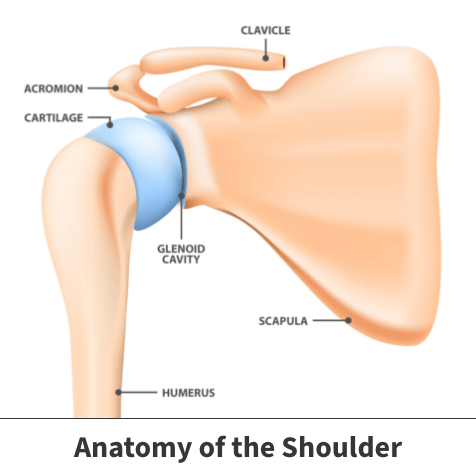Shoulder blade fracture
Fractures of the scapula
Fractures of the shoulder blade are relatively uncommon injuries that result in pain and swelling in the shoulder region. These injuries are caused by high-energy, blunt trauma incidents, such as hard falls or car accidents. This type of fracture is typically treated nonsurgically but may need surgery, depending on the severity. Often, shoulder blade fractures can result in more severe injuries to the lungs, chest, and internal organs. For this reason, it is important to seek medical attention if you think you have fractured your shoulder blade.
Anatomy

Your shoulder consists of three bones: your upper arm bone (humerus), your shoulder blade (scapula), and your collarbone (clavicle). The head of your upper arm bone fits into a rounded socket (the glenoid) in your shoulder blade. Your shoulder blade is a triangular-shaped bone that is protected by a complex system of surrounding muscles.
A combination of muscles and tendons, known as the rotator cuff, keep your arm bone centered in your shoulder socket. The rotator cuff covers the head of your upper arm bone and attaches it to your shoulder blade.
About
Fractures of the shoulder blade occur during high-energy, blunt trauma injuries, such as car accidents or falls from a significant height. These injuries are often accompanied by other injuries to the chest, lungs, and internal organs. For this reason, it is essential to contact your Florida Orthopaedic Institute physician as soon as possible to prevent your injuries from worsening.
Fortunately, these types of fractures are not common, as they represent less than 1% of all broken bones. Shoulder blade fractures occur most often to men ages 25 to 45.
Symptoms
There are several common symptoms of shoulder blade fractures. These symptoms include:
- Extreme pain when moving your arm
- Swelling around the back of the shoulder
- Bruising around the shoulder
- Scrapes around the affected area
Seek emergency medical attention immediately if you experience the following:
- Shortness of breath
- Decreased sensation in the affected arm
- Abdominal pain
Diagnosis
Your Florida Orthopaedic Institute physician will look at your symptoms and check the position and posture of your shoulder. Since other injuries usually go with shoulder blade fractures, your physician will also look for additional damage.
Your physician may order some imaging tests of your shoulder and chest to determine the extent of your injury, such as X-rays, MRI, and CT scans:
- X-rays – provide clear images of dense structures like bone
- MRI (magnetic resonance imaging) – scans of the shoulder are sometimes needed to diagnose fractures of the shoulder socket (glenoid)
- CT (computed tomography) – scan provides a more detailed image of bones, organs and soft tissues

Treatment
There are both surgical and nonsurgical treatments to treat fractures of the shoulder blade. For the most part, they can be treated solely with nonsurgical means. But if the shoulder blade bones are displaced and will not heal correctly, surgery may be needed.
Nonsurgical treatment
Depending on the severity of your shoulder blade fracture, you may only need nonsurgical treatments to heal your injury. Immediately after the injury, it is important to stop moving your arm and apply ice to reduce swelling and discomfort. Typically, nonsurgical treatments involve a sling, which holds the shoulder in place while the bone heals.
Your physician may also want you to start moving your shoulder within the first week after the injury to minimize the risk of shoulder and elbow stiffness. As the pain begins to go away, the sling will eventually not be needed. Stretching exercises should continue until complete shoulder motion returns, which may take six months to 1 year.
Surgical treatment
If the shoulder blade fracture is severe or if it cannot heal on its own, surgical treatments may be necessary. During the surgical procedure, the shoulder blade bone fragments are first repositioned back to their normal alignment and then held in place by attaching metal plates with special screws to the outer surface of the bone.
Related specialties
- AC Joint Injuries
- Atraumatic Shoulder Instability
- Bankart Repair
- Bicep Tenodesis
- Broken Collarbone
- Bursitis of the Shoulder (Subacromial Bursitis)
- Calcific Tendinitis of the Shoulder
- Clavicle Fractures
- Dislocated Shoulder
- Glenoid Labrum Tear
- Impingement Syndrome of the Shoulder
- Little League Shoulder
- Reverse Total Shoulder Replacement
- Rheumatoid Arthritis (RA) of the Shoulder
- Rotator Cuff Tears
- Shoulder Arthritis
- Shoulder Arthroscopy
- Shoulder Injury: Pain in the Overhead Athlete
- Shoulder Replacement
- Shoulder Separations
- Shoulder Socket Fracture (Glenoid Fracture)
- SLAP Tears & Repairs
- Subacromial Decompression
- Trapezius Strain (Muscle Strain Of The Upper Back)
- Traumatic Shoulder Instability
